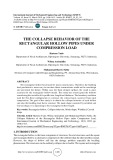
http://www.iaeme.com/IJMET/index.asp 1406 editor@iaeme.com
International Journal of Mechanical Engineering and Technology (IJMET)
Volume 10, Issue 03, March 2019, pp. 1406-1415. Article ID: IJMET_10_03_141
Available online at http://www.iaeme.com/ijmet/issues.asp?JType=IJMET&VType=10&IType=3
ISSN Print: 0976-6340 and ISSN Online: 0976-6359
© IAEME Publication Scopus Indexed
THE COLLAPSE BEHAVIOR OF THE
RECTANGULAR HOLLOW PIPES UNDER
COMPRESSION LOAD
Hartono Yudo
Department of Naval Architecture, Diponegoro University, Semarang, 50275, Indonesia.
Wilma Amiruddin
Department of Naval Architecture, Diponegoro University, Semarang, 50275, Indonesia.
Muhammad Harris Nubly
Division of Computer Aided Design and Engineering, PT. Arisma Data Setia, West Jakarta,
11630, Indonesia
ABSTRACT
The rectangular hollow beam used for many constructions. Therefore, the buckling
load prediction is neces-sary to convince those constructions would not be overdesign
and prevented the failure. Within uses the finite element method, the result is more
accurate for the rectangular hollow model. This study has investi-gated the hollows
considering the variable of its profile size, length and thickness. The boundary condition
used the free-fixed configuration to convince the critical loads occurred from axial
compression. The goal of this study is to obtain the collapse behavior of each hollow
size also the buckling load factor constant. The mode-shape consisted by wrinkled and
Curved shape, it is depending to the rectangular hollow length.
Key words: Rectangular hollow, Collapse behavior, Mode-shape, Wrinkled, Curved
shape
Cite this Article Hartono Yudo, Wilma Amiruddin and Muhammad Harris Nubly, the
Collapse Behavior of the Rectangular Hollow Pipes under Compression Load,
International Journal of Mechanical Engineering and Technology, 10(3), 2019, pp.
1406-1415.
http://www.iaeme.com/IJMET/issues.asp?JType=IJMET&VType=10&IType=3
1. INTRODUCTION
The rectangular hollow is the basic component of structures. Several structures used the square
and rectangular hollow as alternative component for the stiffener than the other profiles instead.
However, the shape of hollow still has the damage problem especially the buckling
phenomenon. The structures can be suddenly collapse due to buckle. The square and rectangular





















